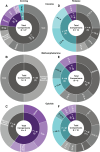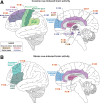Sex Differences in Opioid and Psychostimulant Craving and Relapse: A Critical Review
- PMID: 34987089
- PMCID: PMC11060335
- DOI: 10.1124/pharmrev.121.000367
Sex Differences in Opioid and Psychostimulant Craving and Relapse: A Critical Review
Abstract
A widely held dogma in the preclinical addiction field is that females are more vulnerable than males to drug craving and relapse. Here, we first review clinical studies on sex differences in psychostimulant and opioid craving and relapse. Next, we review preclinical studies on sex differences in psychostimulant and opioid reinstatement of drug seeking after extinction of drug self-administration, and incubation of drug craving (time-dependent increase in drug seeking during abstinence). We also discuss ovarian hormones' role in relapse and craving in humans and animal models and speculate on brain mechanisms underlying their role in cocaine craving and relapse in rodent models. Finally, we discuss imaging studies on brain responses to cocaine cues and stress in men and women.The results of the clinical studies reviewed do not appear to support the notion that women are more vulnerable to psychostimulant and opioid craving and relapse. However, this conclusion is tentative because most of the studies reviewed were correlational, not sufficiently powered, and not a priori designed to detect sex differences. Additionally, imaging studies suggest sex differences in brain responses to cocaine cues and stress. The results of the preclinical studies reviewed provide evidence for sex differences in stress-induced reinstatement and incubation of cocaine craving but not cue- or cocaine-induced reinstatement of cocaine seeking. These sex differences are modulated in part by ovarian hormones. In contrast, the available data do not support the notion of sex differences in craving and relapse/reinstatement for methamphetamine or opioids in rodent models. SIGNIFICANCE STATEMENT: This systematic review summarizes clinical and preclinical studies on sex differences in psychostimulant and opioid craving and relapse. Results of the clinical studies reviewed do not appear to support the notion that women are more vulnerable to psychostimulant and opioid craving and relapse. Results of preclinical studies reviewed provide evidence for sex differences in reinstatement and incubation of cocaine seeking but not for reinstatement or incubation of methamphetamine or opioid seeking.
U.S. Government work not protected by U.S. copyright.
Figures






Similar articles
-
Neurobiology of the incubation of drug craving: An update.Pharmacol Rev. 2025 Mar;77(2):100022. doi: 10.1016/j.pharmr.2024.100022. Epub 2024 Nov 29. Pharmacol Rev. 2025. PMID: 40148031 Review.
-
Dopamine transmission at D1 and D2 receptors in the nucleus accumbens contributes to the expression of incubation of cocaine craving.Neuropsychopharmacology. 2024 Dec;50(2):461-471. doi: 10.1038/s41386-024-01992-2. Epub 2024 Sep 19. Neuropsychopharmacology. 2024. PMID: 39300272
-
Sex differences in the effect of chronic delivery of the buprenorphine analogue BU08028 on heroin relapse and choice in a rat model of opioid maintenance.Br J Pharmacol. 2022 Jan;179(2):227-241. doi: 10.1111/bph.15679. Epub 2021 Oct 27. Br J Pharmacol. 2022. PMID: 34505281 Free PMC article.
-
Decreased incubation of fentanyl seeking in the absence of proximal drug-paired stimuli.Exp Clin Psychopharmacol. 2025 Jun;33(3):239-247. doi: 10.1037/pha0000763. Epub 2025 Jan 2. Exp Clin Psychopharmacol. 2025. PMID: 39745674
-
Parenteral opioids for maternal pain management in labour.Cochrane Database Syst Rev. 2018 Jun 5;6(6):CD007396. doi: 10.1002/14651858.CD007396.pub3. Cochrane Database Syst Rev. 2018. PMID: 29870574 Free PMC article.
Cited by
-
Abstinence-Dependent Effects of Long-Access Cocaine Self-Administration on Nucleus Accumbens Astrocytes Are Observed in Male, But Not Female, Rats.eNeuro. 2022 Sep 21;9(5):ENEURO.0310-22.2022. doi: 10.1523/ENEURO.0310-22.2022. Print 2022 Sep-Oct. eNeuro. 2022. PMID: 35995558 Free PMC article.
-
Neurobiological mechanisms and related clinical treatment of addiction: a review.Psychoradiology. 2022 Dec 16;2(4):180-189. doi: 10.1093/psyrad/kkac021. eCollection 2022 Dec. Psychoradiology. 2022. PMID: 38665277 Free PMC article. Review.
-
Influence of gut microbiome metabolites on cocaine demand and cocaine-seeking behavior.Neuropsychopharmacology. 2024 Jan;49(2):357-358. doi: 10.1038/s41386-023-01743-9. Epub 2023 Sep 22. Neuropsychopharmacology. 2024. PMID: 37740056 Free PMC article. No abstract available.
-
Contemporaneous Link Between Pain and Craving in Patients Recovering from Prescription Opioid Use Disorder During Residential Treatment.Subst Use Misuse. 2025;60(7):978-988. doi: 10.1080/10826084.2025.2478590. Epub 2025 Mar 20. Subst Use Misuse. 2025. PMID: 40114409
-
An Epigenetic Mechanism Promoting Heroin Relapse After Prolonged Abstinence.Biol Psychiatry. 2025 Mar 15;97(6):552-553. doi: 10.1016/j.biopsych.2024.12.013. Biol Psychiatry. 2025. PMID: 39971399 Free PMC article. No abstract available.
References
-
- Adelson M, Linzy S, Peles E (2018) Characteristics and outcome of male and female methadone maintenance patients: MMT in Tel Aviv and Las Vegas. Subst Use Misuse 53:230–238. - PubMed
-
- Ahmed SH, Walker JR, Koob GF (2000) Persistent increase in the motivation to take heroin in rats with a history of drug escalation. Neuropsychopharmacology 22:413–421. - PubMed

